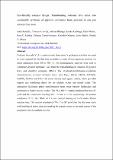Eco-friendly catalyst design: Transforming volcanic lava ashes into sustainable synthesis of glycerol carbonate from glycerol in one pot solvent-free route

View/
Date
2025-04Author
Kandola, Isack
Kivevele, Thomas
Hilonga, Askwar
Kichonge, Baraka
Maina, Paulo
Ramkat, Rose
Castro-Ocampo, Orlando
Delesma, Cornelio
Muñiz, Jesús
Okoye, Patrick
Metadata
Show full item recordAbstract
Volcanic lava ash (VLA), a natural waste from nature’s geological activities was used as a raw material for the first time to produce a series of heterogeneous catalysts via facile calcination from 300 to 900 °C. The heterogeneous catalysts were used to synthesize glycerol carbonate (GC) from the transesterification reaction of glycerol (GL) and dimethyl carbonate (DMC). The structural-morphological-crystalline characterization revealed dominant active sites Mg1.04 (SiO3), CK2O3, KAlSiO4, Na3PO4, NaAlO2 and CaO with some silicates and organic carbon, which provided support and stabilizing effects for the alkaline oxides and mixed oxides. The calcination facilitated phase transformation from lower basicity hydroxides and carbonates to higher basicity oxides. The VLA-800 °C catalyst produced the best GC yield and GL conversion reaching 91 ± 1 % and 97 ± 3 %, respectively, at reaction conditions 75 °C, GL: DMC of 1:3, and catalyst loading of 5 wt% under 90 min reaction time. The catalyst maintained (74 ± 1 %) GC yield after the 6th reuse cycle with leaching of active sites and masking by organic matter as the main causes of the progressive loss in catalytic activity.
URI
https://doi.org/10.1016/j.jece.2025.116030https://dspace.nm-aist.ac.tz/handle/20.500.12479/2993
